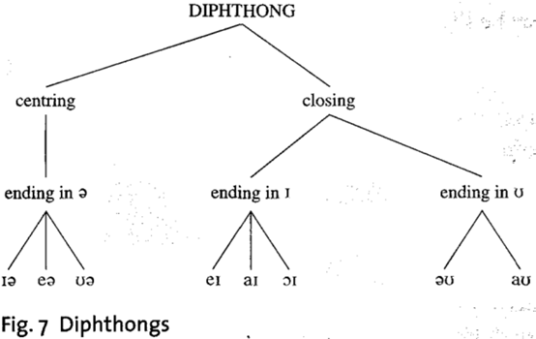vowels
Classification of Vowels
We can classify the vowel sounds considering four different criteria:
tongue height
It refers to how high or low our tongue is. Thus we can say that /i/ is a high vowel sound, /e/ is intermediate, and /a/ is low. You may notice the movement of the tongue if you pronounce these three sounds.
tongue position
When we make a vowel sound, our tongue is in a specific position inside our mouth. For example, if you make the vowel sound /i/ and then /u/, you will notice that your tongue moves back, and if you make the sound /i/ and then /a/, your tongue moves down. The following chart shows the position of the tongue when we pronounce the English vowel sounds. You have to imagine that this chart is inside the mouth. For each sound, there is one phonetic symbol that belongs to the International Phonetic Alphabet.
lip rounding
It refers to the position of our lips, when we make the vowel sounds. When we make the sound /i/, the corners of our mouth are further apart, so we can say that this is a spread vowel sound. When we pronounce /u/, our lips are rounded, and for the sound /a/ our lips are neither spread nor rounded, so we say that it is an unrounded vowel or neutral.
Short Vowels

/ʌ/ under, enough, butter
/i/ silly, baby
/e/ , want, cough edge, lead
/æ/ apple, man
/ʊ/ put, full
/ə/ above, support, possible, Africa, moth
Long vowels

The five long vowels are different from the six short vowels described in Chapter 7, not only in length but also in quality. If we compare some similar pairs of long and short vowels, for example a with a:, or i with i: we can see distinct differences in quality (resulting from differences in tongue shape and position, and lip position) as well as in length. For this reason, all the long vowels have symbols which are different from those of short vowels; you can see that the long and short vowel symbols would still all be different from each other even if we omitted the length mark, so it is important to remember that the length mark is used not because it is essential but because it helps learners to remember the length difference.
i: (example words: 'beat', 'mean', 'peace') This vowel is nearer to cardinal vowel no. 1 [i] (i.e. it is closer and more front) than is the short vowel of 'bid', 'pin', 'fish' described in Chapter 7. Although the tongue shape is not much different from cardinal vowel no. 1, the lips are only slightly spread and this results in a rather different vowel quality.
3: (example words: 'bird', 'fern', 'purse') This is a mid-central vowel which is used in most English accents as a hesitation sound (written 'er'), but which many learners find difficult to copy. The lip position is neutral.
a: (example words: 'card', 'half, 'pass') This is an open vowel in the region of cardinal vowel no. 5 [a], but not as back as this. The lip position is neutral.
: (example words: 'board', 'torn', 'horse') The tongue height for this vowel is between cardinal vowel no. 6 [c] and no. 7 [o], and closer to the latter. This vowel is almost fully back and has quite strong lip-rounding.
U: (example words: 'food', 'soon', 'loose') The nearest cardinal vowel to this is no. 8 [u], but BBC u: is much less back and less close, while the lips are only moderately rounded.
Diphthongs
In terms of length, diphthongs are similar to the long vowels described above. Perhaps the most important thing to remember about all the diphthongs is that the first part is much longer and stronger than the second part; for example, most of the diphthong ai (as in the words 'eye', 'I') consists of the a vowel, and only in about the last quarter of the diphthong does the glide to I become noticeable. As the glide to i happens, the loudness of the sound decreases. As a result, the i part is shorter and quieter. Foreign learners should, therefore, always remember that the last part of English diphthongs must not be made too strongly

Triphthongs
A triphthong is a glide from one vowel to another and the to a third, all produced rapidly and without interruption







